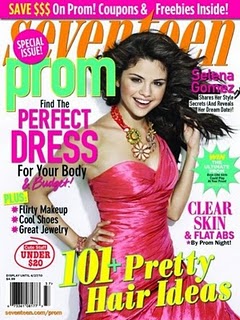Teen Girl Magazine Tips — And a Girl Who Is Living By Them
Posted on June 27, 2010 at 3:58 pm
Eight years ago, I wrote an article for the Chicago Tribune about magazines for teen girls.
Like Cosmo Girl, Twist, Teen and other magazines aimed at teenage girls, Seventeen strikes an uneasy balance between being empowering and being trashy. This is the result of another uneasy balance between their two constituencies, readers and advertisers. Girls want to attract boys. Advertisers want to avoid controversy.
The magazines are filled with tips on dating, fashion, makeup, managing stress, decorating and hair. After all, those of us with two X chromosomes love tips. Women secretly believe that all problems can be solved, usually with the female equivalent of duct tape: twist-ties, scrunchies, nail polish remover and cucumber slices. We love tips that make us feel like we are improving anything.
The magazines have tips on more than good grooming and accessorizing. Cosmo Girl’s internship survival guide has first-class information and lots of good advice about finding a job, acing the interview and demonstrating professionalism and commitment in the office.
An eighteen-year-old named Jamie Keiles has undertaken something she calls The Seventeen Project. She is living her life by the magazine’s tips for one month and documenting the results online. This will be good practice for college; the site notes that she will be studying economics and gender studies at the University of Chicago in the fall of 2010.
Keiles is sharp and funny about herself as well as the magazine. She is pleased with the results of a hairstyle she tries from the magazine until she looks at it again and finds that it was voted “not” by the magazine’s readers. I loved her comment on some of the dresses in the special prom issue: “Seventeen calls this trend ‘High-Low’ but I think ‘Mullet Dress would be a more fitting name.” She has some very thoughtful comments on the glossy magazine’s portrayal of race, gender, sexual orientation, and sex. “Teen mags often do better in the race department than their adult counterparts, including women of a variety of races and even offering some pretty level-headed advice on interracial dating. Still, out of curiosity, I wondered exactly how the racial content of Seventeen broke down. So I counted!” Keiles was pleased to find that the races of the models in the magazine were proportionate to the races in the US census, with the significant exception of Hispanics. But she astutely noted that there was more racial variety in the females than the males. “It seems like Seventeen’s idea of female beauty is more varied, while the races that are considered attractive for males are extremely more limited.” What could have been a stunt is an engaging, impressive, and nuanced assessment of the magazine, its advertisers, and its readers. We worry so much about media messages and the way they influence children and teenagers. It is a pleasure to see this kind of objectivity and analysis from a young woman. I hope she gets a lot of readers and I look forward to her next project.

